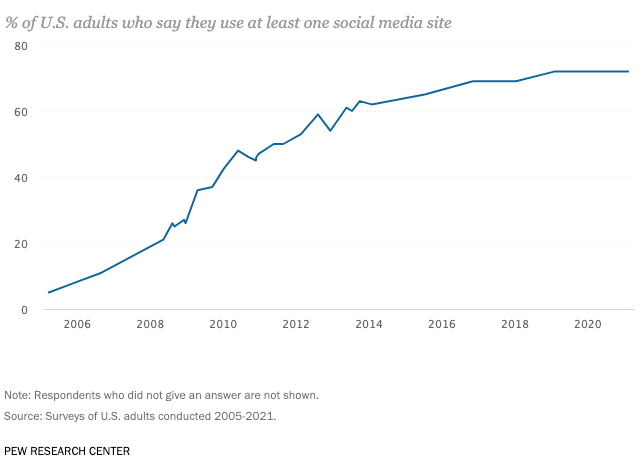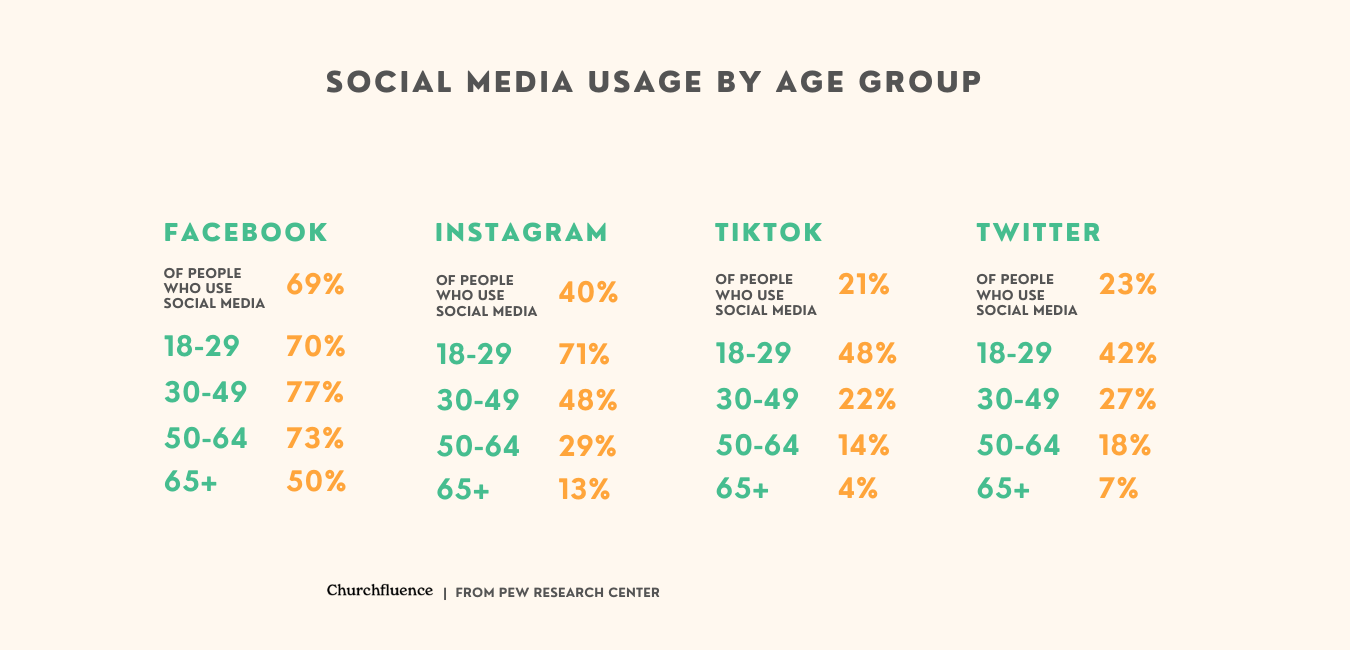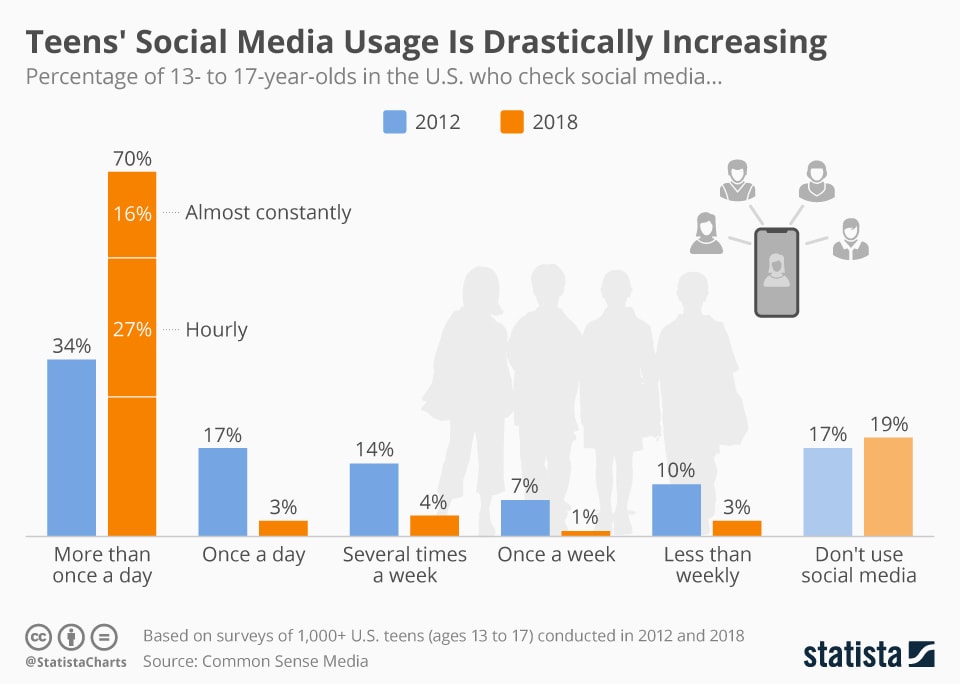Do you run your church’s social media account?
Maybe it’s Instagram or Facebook or Tiktok or maybe all of the above. Nowadays, it seems impossible to grow as a church without at least one form of social media.
But running and managing a church’s social media strategy isn’t easy. There are so many social media platforms, so many trends, and so many different ways to grow and flop. What works and what doesn’t?
In this podcast, we’ll break down everything you need to know about church and social media. We’ll look at some stats and then get into a bunch of different tips and tricks you can use to grow and flourish online.
Let’s get into it.
Estimated reading time: 9 minutes
Table of contents
Churches and Social Media

In 2024, social media remains essential for churches aiming to strengthen their outreach and community engagement. As more people turn to online platforms for connection and inspiration, churches that adapt benefit from enhanced reach and relevance.
Social media offers pastors and ministry leaders opportunities to share sermons, devotionals, and updates in real-time while fostering interactions that go beyond Sunday services. Platforms like Instagram, TikTok, and YouTube dominate with their visual and interactive appeal, making short videos and stories crucial tools for spreading messages and inviting engagement.
But what do the stats say? And how can we use these numbers to help us manage our social media accounts?
Who’s On Social Media?
So what’s the big deal? Why put time and energy into managing social media accounts?
Well, social media is the primary way we connect in 2024. According to Pew Research Center, 72% of people in America say they use at least one social media site.

Church growth is also always important, and unless you’re a big church that is so popular it can grow just by being popular alone, you need a way to reach new people and keep the people you already have.
Businesses use social media to grow as well. Now, your church is not about “marketing” or making money, it’s about serving God and your community. But if businesses are finding success growing by using social media, that’s a good sign we can too.
Social Media Platforms
There are many popular social media platforms you can use these days. But which ones are best? Focusing on only one or two platforms is wise starting out, especially if you need to save time and energy. That means you’ll need to choose the social media platform that is right for you!
According to Churchfluence, we can see what social media platforms are popular for what age groups.

These numbers can help your church decide what social media platforms to pursue. For example, if the majority of your church is under 30, Instagram and/or Tiktok is the way to go. If your church is above 30, Facebook may be a better option.
Reaching Youth
Is your church struggling to reach youth and young adults? Well, you’re not alone.
Most churches nowadays find it difficult to grow in young members. There are a lot of reasons for this, which we won’t get into now, but it’s important to know how powerful social media can be to reach young people!
According to Statista, 70% of teenagers check social media more than once a day.

Oh yeah, and that was in 2018. Imagine how high that number is now! If that number increased from 34% to 70% in 2012 to 2018 (a 6-year gap), how much higher is it now in 2024 (another 6-year gap)?
7 Church Social Media Hacks

So now we know that using social media for church growth is smart. Which platforms to choose and such is up to you and your church, but having at least one social media account is wise.
Now, let’s get into 7 social media hacks that can help your church grow online. It’s not enough to just have the accounts, it matters what you post, when you post, and why you post. And these hacks should get you on your way.
Let’s dive in.
1. Consistency
Consistency is key when it comes to church social media posts. Regular posting helps keep your church community engaged and informed. When church members see new content regularly, they feel connected and valued, even outside of Sunday services.
Posting consistently also means your church stays visible on social media feeds, which can attract new followers and potential visitors.
Remember, it’s not just about quantity but quality too. Each post should reflect your church’s mission and values. By being consistent with your church social media posts, your church community will grow stronger, more connected, and more engaged.
2. Stories
Posting stories is an effective way to boost your church’s social media presence. Stories are short, engaging, and allow your church to share quick updates, behind-the-scenes moments, or daily encouragement. This simple format is perfect for keeping your content fresh and relatable.
As part of your social media strategies, stories can make your church feel more approachable and connected. Use them to share scripture verses, event reminders, or short clips of worship practice. Stories are interactive, so add polls or questions to engage your church members.
By regularly posting stories, your social media presence becomes more dynamic and welcoming. This helps your church stay in the minds and hearts of your members and reach out to new people.
3. Short-Form Videos
Short-form videos are great tools for social ministry. They deliver inspiring messages quickly and keep people engaged. Here’s why they’re effective:
- Quick Impact: Capture attention in under a minute with powerful, uplifting messages.
- Easy to Share: These videos are perfect for spreading your church’s message to a wider audience.
- Flexible Content: Use them for devotionals, event highlights, or community shout-outs.
- Platform Reach: Post on Instagram Reels, TikTok, or YouTube Shorts for maximum engagement.
- Daily Inspiration: Keep your church members connected and motivated with regular, short updates.
Short-form videos make your church’s social media presence more engaging and meaningful.
4. Sermon Highlights
Sermon highlights are a great way to keep your church online presence active and engaging. By sharing short clips of your weekly sermons, you give people a taste of the powerful, inspirational messages from your services.
These highlights can reach church members who missed the full service and inspire them throughout the week. They are also a way for new people to discover your church and feel connected before attending.
Post these highlights on social media to share impactful moments that resonate. Sermon highlights are simple but effective tools for spreading your message and uplifting others in their daily lives.
5. Content Calendar

A content calendar is a helpful tool for managing your church’s social media. It helps you plan posts in advance, ensuring a balanced mix of devotionals, sermon highlights, and church events.
With a content calendar, you stay organized and consistent, making sure important dates and activities are never missed. It also simplifies scheduling, giving your church more time to focus on engaging with the community and creating meaningful content.
And if you want a FREE content calendar resource with monthly themes, 365 daily post ideas, and pre-marked holidays and special dates, check it out here!
6. Repurpose Content
Repurposing content is a smart way to keep your church’s social media active without starting from scratch. Here’s how to do it:
- Sermon Clips: Turn full sermons into short video highlights.
- Quotes: Share impactful sermon quotes as text or graphic posts.
- Blog Posts: Transform sermon series into blog articles.
- Reels and Stories: Use existing photos and videos for quick social media stories.
Repurposing content saves time and keeps your social media fresh and engaging.
7. Optimize Visuals
Optimizing visuals is important for your church’s social media. High-quality images and videos capture attention and make your posts more appealing. Use good lighting and clear angles when taking photos of church events or activities.
Adding your church logo or brand colors helps create a consistent look. Tools like Canva can help you design eye-catching graphics for announcements or inspirational quotes. By optimizing visuals, you enhance your church’s online presence and encourage more engagement from your community.
8. Authenticity
Authenticity is essential for churches on social media. Being genuine helps build trust and foster community among members. A solid social media policy and clear social media guidelines can help ensure your posts reflect your church’s values. Share real stories, personal experiences, and behind-the-scenes moments to connect with your audience.
When your church shows authenticity, it encourages engagement and creates a welcoming space where people feel valued and understood. This genuine approach strengthens relationships and attracts new members to your church community.
Church Social Media

Incorporating these social media strategies can greatly enhance your church’s outreach and connection with the community. By focusing on authenticity, consistency, and engaging content, you create a welcoming online presence.
Embrace these practices to inspire your church members and reach new audiences, making a lasting impact in their lives.
More Resources on Social Media





